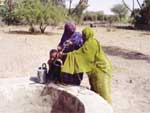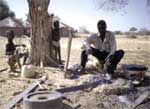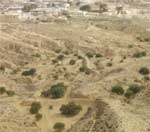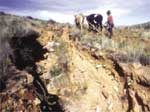



Context - Desertification is the persistent degradation of dryland ecosystems.
It threatens the livelihoods of some of the poorest and most vulnerable populations on the planet. Desertification is largely caused by unsustainable use of scarce resources.
What options exist to avoid or reverse desertification and its negative impacts?
This Digest is a faithful summary of the leading scientific consensus report produced in 2005 by the Millennium Ecosystem Assessment (MA): "![]()
Desertification is the persistent degradation of dryland ecosystems by variations in climate and human activities. Home to a third of the human population in 2000, drylands occupy nearly half of Earth’s land area. Across the world, desertification affects the livelihoods of millions of people who rely on the benefits that dryland ecosystems can provide.
In drylands, water scarcity limits the production of crops, forage, wood, and other services ecosystems provide to humans. Drylands are therefore highly vulnerable to increases in human pressures and climatic variability, especially sub-Saharan and Central Asian drylands.
Some 10 to 20% of drylands are already degraded, and ongoing desertification threatens the world’s poorest populations and the prospects of poverty reduction. Therefore, desertification is one of the greatest environmental challenges today and a major barrier to meeting basic human needs in drylands. More...
2.1 In drylands, more people depend on ecosystem services for their basic needs than in any other ecosystem. Indeed, many of their resources, such as crops, livestock, fuelwood, and construction materials, depend on the growth of plants, which in turn depends on water availability and climate conditions.
Fluctuations in the services supplied by ecosystems are normal, especially in drylands, where water supply is irregular and scarce. However, when a dryland ecosystem is no longer capable to recover from previous pressures, a downward spiral of desertification may follow, though it is not inevitable. More...
2.2 Desertification affects a wide range of services provided by ecosystems to humans: products such as food and water, natural processes such as climate regulation, but also non-material services such as recreation, and supporting services such as soil conservation. Changes can be quantified and methods are available to prevent, reduce, or reverse them.
When faced with desertification, people often respond by making use of land that is even less productive, transforming pieces of rangeland into cultivated land, or moving towards cities or even to other countries. This can lead to unsustainable agricultural practices, further land degradation, exacerbated urban sprawl, and socio-political problems. More...
Desertification affects the livelihoods of millions of people, as it occurs on all continents (except Antarctica).

3.1 Desertification takes place in drylands all over the world. Some 10 to 20% of all drylands may already be degraded, but the precise extent of desertification is difficult to estimate, because few comprehensive assessments have been made so far. More...
3.2 A large majority of dryland populations live in developing countries. Compared to the rest of the world, these populations lag far behind in terms of human well-being, per capita income, and infant mortality. The situation is worst in the drylands of Asia and Africa. Dryland populations are often marginalized and unable to play a role in decision making processes that affect their well-being, making them even more vulnerable. More...
3.3 Desertification has environmental impacts that go beyond the areas directly affected. For instance, loss of vegetation can increase the formation of large dust clouds that can cause health problems in more densely populated areas, thousands of kilometers away. Moreover, the social and political impacts of desertification also reach non-dryland areas. For example, human migrations from drylands to cities and other countries can harm political and economic stability. More...
Desertification is caused by a combination of social, political, economic, and natural factors which vary from region to region.

4.1 Policies that can lead to an unsustainable use of resources and lack of infrastructures are major contributors to land degradation. Agriculture can play either a positive or a negative role, depending on how it is managed. Policies favoring sedentary farming over nomadic herding in regions more suited to grazing can contribute to desertification. More...
4.2 The process of globalization both contributes to desertification and helps prevent it. Studies have shown that, in some cases, trade liberalization, economic reforms, and export-oriented production in drylands can promote desertification. In other cases, enlarged markets outside of the drylands also contribute to successful agricultural improvements. More...
4.3 Historically, dryland livelihoods have been based on a mixture of hunting, gathering, farming, and herding. This mixture varied with time, place, and culture, since the harsh conditions forced people to be flexible in land use. Population growth has led to the extension of cultivated lands and the irrigation of these lands has brought about desertification, as well as other environmental problems. More...
Population growth and increased food demand are expected to drive the expansion and intensification of land cultivation in drylands. If no countermeasures are taken, desertification in drylands will threaten future improvements in human well-being and possibly reverse gains in some regions.
5.1 The Millennium Ecosystem Assessment developed four plausible scenarios to explore the future of desertification and human well-being until 2050 and beyond. The different scenarios are based on either increased globalization or increased regionalization, each combined with either a reactive or proactive way of addressing environmental issues. More...

5.2 In all four scenarios, the desertified area is expected to increase, though not at the same pace. Poverty and unsustainable land use practices will continue to be the main factors driving desertification in the near future, and climate change will also play a role. More...
5.3 Local adaptation and conservation practices can mitigate some losses of dryland services, but it will be difficult to reverse losses in terms of biodiversity and in the provision of food and water which is linked to biodiversity. Freshwater scarcity, which already affects 1-2 billion people globally, is expected to increase, causing greater stresses in drylands and ultimately a worsening of desertification.
The implementation of the U.N. Convention to Combat Desertification (UNCCD) would be particularly difficult in a regionalized-reactive world (Order from strength scenario), while prospects would improve in a more globalized world with proactive ecosystem management (TechnoGarden scenario). More...
Effective prevention of desertification requires management and policy approaches that promote sustainable resource use. Prevention should be preferred to rehabilitation, which is difficult and costly.

6.1 Major policy interventions and changes in management approaches, both at local and global levels, are needed in order to prevent, stop or reverse desertification. Prevention is a lot more cost-effective than rehabilitation, and this should be taken into account in policy decisions. Addressing desertification is critical and essential to meeting the Millennium Development Goals which aim to eradicate extreme poverty and ensure environmental sustainability amongst other objectives. More...
6.2 The creation of a “culture of prevention” that promotes alternative livelihoods and conservation strategies can go a long way toward protecting drylands both when desertification is just beginning and when it is ongoing. It requires a change in governments’ and peoples’ attitudes. Building on long-term experience and active innovation, dryland populations can prevent desertification by improving agricultural and grazing practices in a sustainable way. More...
6.3 Even once land has been degraded, rehabilitation and restoration measures can help restore lost ecosystem services. The success of rehabilitation practices depends on the availability of human resources, funds, and infrastructures. It requires a combination of policies and technologies and the close involvement of local communities. More...
Desertification diminishes biological diversity, a diversity which contributes to many of the services provided to humans by dryland ecosystems. Vegetation and its diversity are key for soil conservation and for the regulation of surface water and local climate. Desertification also contributes to global climate change by releasing to the atmosphere carbon stored in dryland vegetation and soils.
The effect of global climate change on desertification is complex and not yet sufficiently understood. On the one hand, higher temperatures resulting from increased carbon dioxide (CO2) levels can have a negative impact through increased loss of water from soil and reduced rainfall in drylands. On the other hand, for certain species, an increase in carbon dioxide in the atmosphere can boost plant growth.
Environmental management approaches for combating desertification, conserving biodiversity, and mitigating climate change are linked in many ways, thus a joint implementation of the U.N. Conventions to Combat Desertification, on Biological Diversity, and on Climate Change can yield multiple benefits. More...

8.1 Scientifically robust and consistent information about the extent of land degradation is important when it comes to identifying priorities and monitoring the consequences of actions.
Previous assessments had diverse shortcomings that made them unreliable. Remote sensing and long term monitoring are needed to better understand desertification processes and determine the extent of desertification. Additionally, to better comprehend the impacts of desertification on human well-being we need to improve our knowledge of the interactions between socioeconomic factors and changing ecosystem conditions. More...
8.2 Uncertainties remain about the way various biological, physical, social, and economic factors interact, which limits our ability to assess the actual effect of policies on desertification. Among other things, the impact of poverty reduction strategies on ecosystem services and desertification has not yet been fully explored. The impact of cities in dryland areas also has to be evaluated, since they may both increase and relieve pressures on desertified areas. More...
Desertification poses one of the greatest environmental challenges today and constitutes a major barrier to meeting basic human needs in drylands.
Desertification is land degradation that affects biological productivity as well as the livelihoods of millions of people. It is caused by a combination of human and natural factors that contribute to an unsustainable use of scarce natural resources.
Some 10 to 20% of drylands are already degraded, and the ongoing desertification threatens the world’s poorest populations. Various scenarios that explore the future of desertification and human well-being in drylands show that global desertified area is likely to increase. Prevention is the most effective way to cope with desertification, because later attempts to rehabilitate desertified areas are costly and tend to deliver limited results. Combating desertification yields multiple local and global benefits and helps fight biodiversity loss and global climate change.
Efforts to reduce pressures on dryland ecosystems need to go hand in hand with efforts to reduce poverty as both are closely linked. Effectively fighting desertification will help reduce global poverty and will contribute to meeting the Millennium Development Goals. More...

This summary is free and ad-free, as is all of our content. You can help us remain free and independant as well as to develop new ways to communicate science by becoming a Patron!